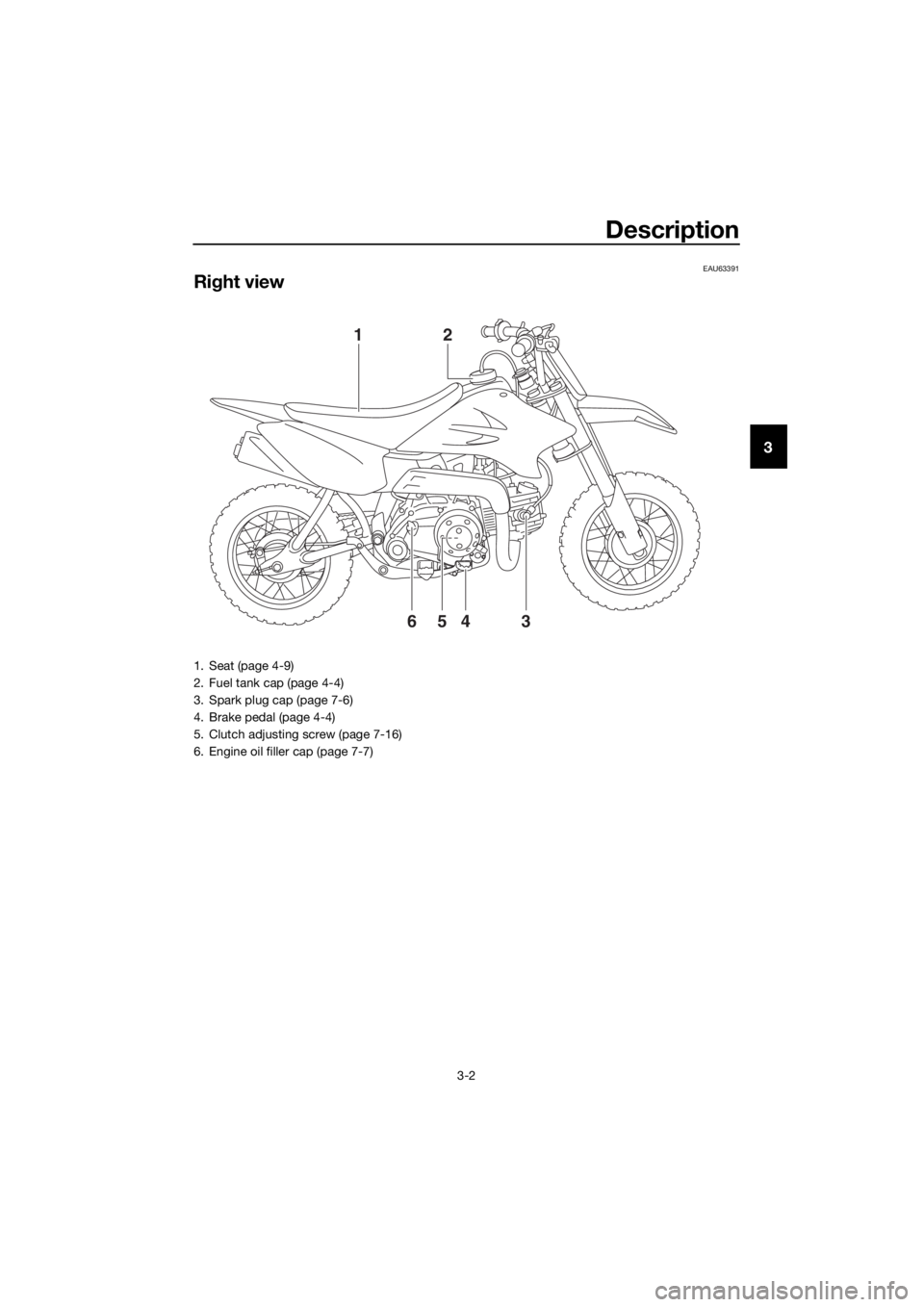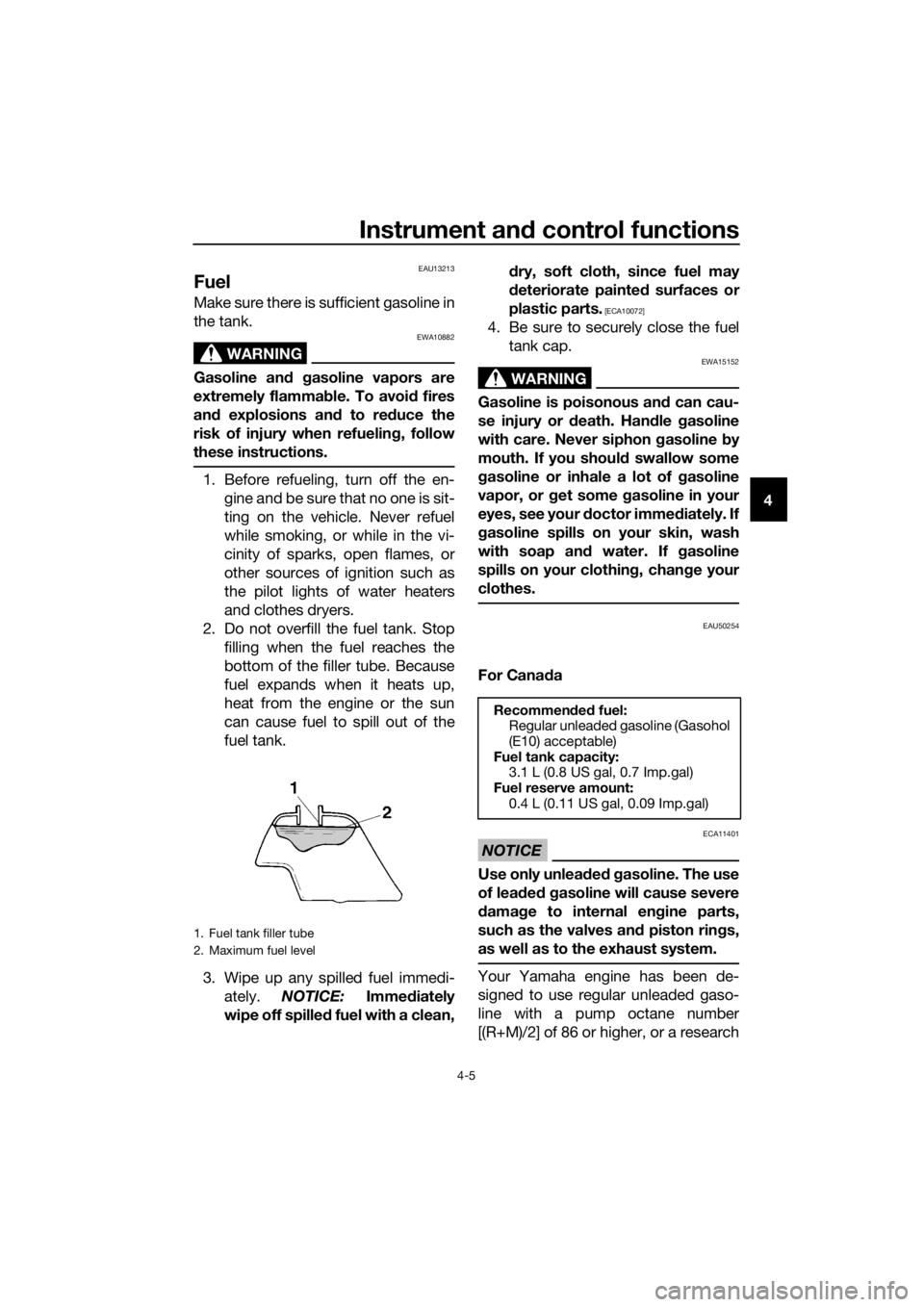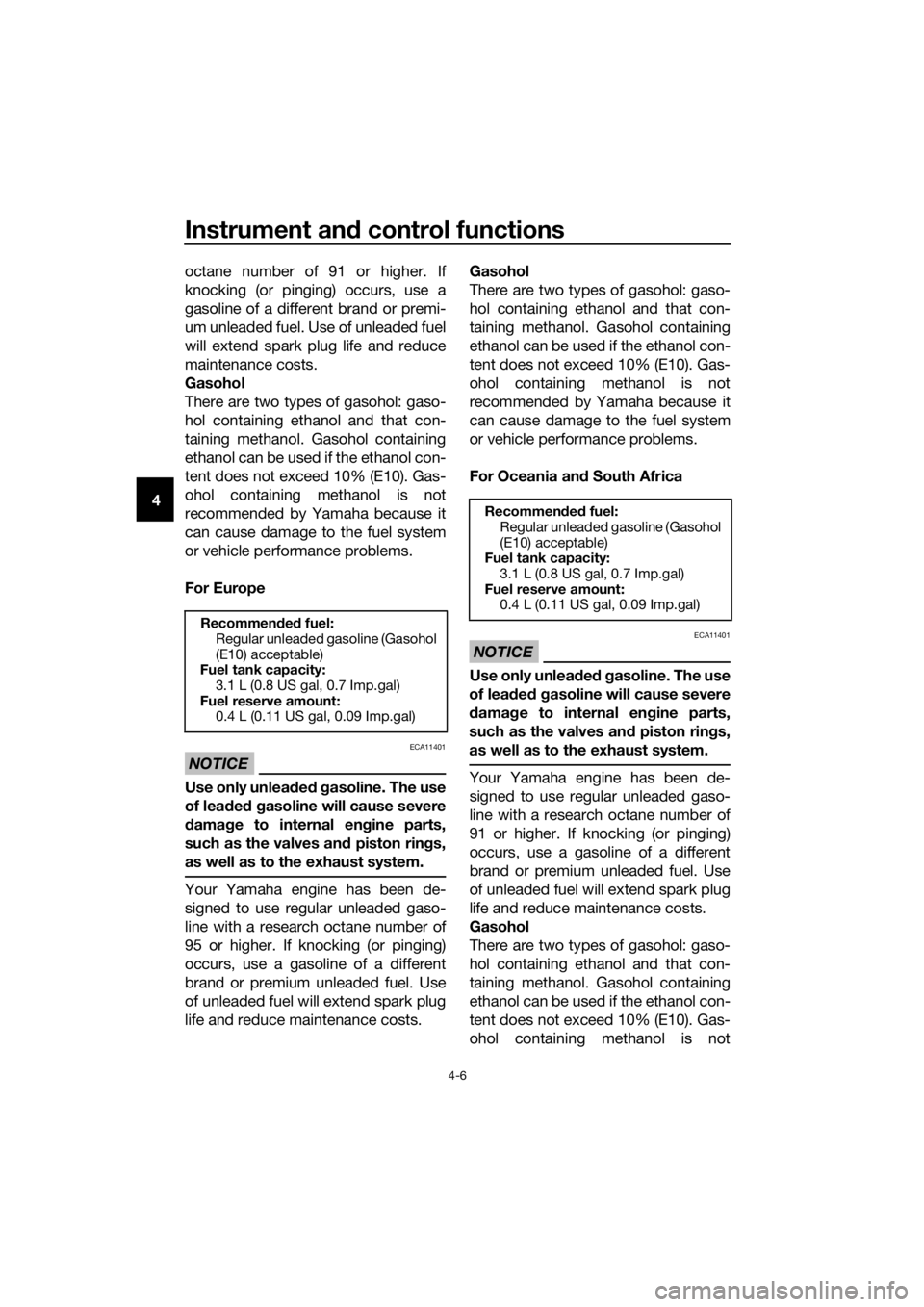fuel cap YAMAHA TT-R50E 2016 Owners Manual
[x] Cancel search | Manufacturer: YAMAHA, Model Year: 2016, Model line: TT-R50E, Model: YAMAHA TT-R50E 2016Pages: 90, PDF Size: 1.97 MB
Page 8 of 90

Table of contents
Location of important la bels ........... 1-1
Safety information ............................ 2-1
Description ....................................... 3-1
Left view ......................................... 3-1
Right view ....................................... 3-2
Controls and instruments ............... 3-3
Instrument an d control functions ... 4-1
Main switch .................................... 4-1
Handlebar switches ........................ 4-1
Speed limiter .................................. 4-2
Shift pedal ...................................... 4-3
Brake lever...................................... 4-3
Brake pedal .................................... 4-4
Fuel tank cap .................................. 4-4
Fuel ................................................. 4-5
Fuel tank breather hose.................. 4-7
Fuel cock ........................................ 4-8
Starter (choke) lever ...................... 4-9
Seat ................................................ 4-9
Sidestand ..................................... 4-10
Starting circuit cut-off system ...... 4-10
For your safety – pre-operation
checks ............................................... 5-1
Operation an d important ri din g
points ................................................ 6-1
Starting and warming up a cold engine ......................................... 6-1
Starting a warm engine .................. 6-2
Shifting ........................................... 6-2
Engine break-in .............................. 6-3
Parking ........................................... 6-4
Perio dic maintenance an d
a d justment ........................................ 7-1
Periodic maintenance chart for the emission control system ............. 7-3
General maintenance and lubrication chart .......................... 7-4
Checking the spark plug ................ 7-6
Engine oil ........................................ 7-7
Cleaning the air filter element ......... 7-9 Cleaning the spark arrester ........... 7-10
Adjusting the carburetor ............... 7-11
Adjusting the engine idling
speed ......................................... 7-12
Checking the throttle grip free
play ............................................ 7-13
Valve clearance ............................. 7-13
Tires .............................................. 7-14
Spoke wheels ................................ 7-15
Adjusting the clutch free play........ 7-16
Adjusting the brake lever free play ............................................ 7-17
Adjusting the brake pedal free play ............................................ 7-18
Checking the shift pedal ............... 7-19
Checking the front and rear brake shoes ......................................... 7-19
Drive chain slack ........................... 7-20
Cleaning and lubricating the drive chain .......................................... 7-21
Checking and lubricating the cables ........................................ 7-22
Checking and lubricating the
throttle grip and cable ............... 7-22
Checking and lubricating the brake lever ................................. 7-23
Checking and lubricating the brake pedal ................................ 7-23
Checking and lubricating the
sidestand ................................... 7-24
Lubricating the swingarm pivots ... 7-24
Checking the front fork ................. 7-25
Checking the steering ................... 7-25
Checking the wheel bearings ........ 7-26
Battery........................................... 7-26
Replacing the fuse ........................ 7-28
Supporting the motorcycle ........... 7-29
Front wheel ................................... 7-29
Rear wheel .................................... 7-31
Troubleshooting ............................ 7-33
Troubleshooting chart ................... 7-34
Motorcycle care an d stora ge .......... 8-1
Matte color caution ......................... 8-1
Care................................................. 8-1
Storage............................................ 8-4
U2CJ83E0.book Page 1 Friday, June 26, 2015 10:36 AM
Page 22 of 90

Safety information
2-4
2Aftermarket Parts, Accessories, an
d
Mo difications
While you may find aftermarket prod-
ucts similar in design and quality to
genuine Yamaha accessories, recog-
nize that some aftermarket accesso-
ries or modifications are not suitable
because of potential safety hazards to
you or others. Installing aftermarket
products or having other modifications
performed to your vehicle that change
any of the vehicle’s design or operation
characteristics can put you and others
at greater risk of serious injury or
death. You are responsible for injuries
related to changes in the vehicle.
Keep the following guidelines in mind,
as well as those provided under “Load-
ing” when mounting accessories. Never install accessories that
would impair the performance of
your motorcycle. Carefully inspect
the accessory before using it to
make sure that it does not in any
way reduce ground clearance or
cornering clearance, limit suspen-
sion travel, steering travel or con-
trol operation.
• Accessories fitted to the han- dlebar or the front fork area can
create instability due to improp-
er weight distribution. If acces-
sories are added to the
handlebar or front fork area,
they must be as lightweight as
possible and should be kept to
a minimum.
• Bulky or large accessories may seriously affect the stability of
the motorcycle. Wind may at- tempt to lift the motorcycle, or
the motorcycle may become
unstable in cross winds.
• Certain accessories can dis- place the operator from his or
her normal riding position. This
improper position limits the
freedom of movement of the
operator and may limit control
ability, therefore, such accesso-
ries are not recommended.
Use caution when adding electri-
cal accessories. If electrical ac-
cessories exceed the capacity of
the motorcycle’s electrical sys-
tem, an electric failure could re-
sult, which could cause a
dangerous loss of lights or engine
power.
Aftermarket Tires an d Rims
The tires and rims that came with your
motorcycle were designed to match
the performance capabilities and to
provide the best combination of han-
dling, braking, and comfort. Other
tires, rims, sizes, and combinations
may not be appropriate. Refer to page
7-14 for tire specifications and more in-
formation on replacing your tires.
Transportin g the Motorcycle
Be sure to observe following instruc-
tions before transporting the motorcy-
cle in another vehicle. Remove all loose items from the
motorcycle.
Check that the fuel cock (if
equipped) is in the “OFF” position
and that there are no fuel leaks.
U2CJ83E0.book Page 4 Friday, June 26, 2015 10:36 AM
Page 25 of 90

Description
3-2
3
EAU63391
Right view
4
65 3 2
1
1. Seat (page 4-9)
2. Fuel tank cap (page 4-4)
3. Spark plug cap (page 7-6)
4. Brake pedal (page 4-4)
5. Clutch adjusting screw (page 7-16)
6. Engine oil filler cap (page 7-7)
U2CJ83E0.book Page 2 Friday, June 26, 2015 10:36 AM
Page 30 of 90

Instrument and control functions
4-4
4
EAU12944
Brake ped al
The brake pedal is located on the right
side of the motorcycle. To apply the
rear brake, press down on the brake
pedal.
EAU13183
Fuel tank cap
To remove the fuel tank cap, turn it
counterclockwise, and then pull it off.
To install the fuel tank cap, insert it into
the tank opening, and then turn it
clockwise.
WARNING
EWA11092
Make sure that the fuel tank cap is
properly close d after fillin g fuel.
Leakin g fuel is a fire hazar d.
1. Brake pedal
1
1. Fuel tank cap
1
U2CJ83E0.book Page 4 Friday, June 26, 2015 10:36 AM
Page 31 of 90

Instrument and control functions
4-5
4
EAU13213
Fuel
Make sure there is sufficient gasoline in
the tank.
WARNING
EWA10882
Gasoline an d gasoline vapors are
extremely flamma ble. To avoi d fires
an d explosions an d to re duce the
risk of injury when refuelin g, follow
these instructions.
1. Before refueling, turn off the en- gine and be sure that no one is sit-
ting on the vehicle. Never refuel
while smoking, or while in the vi-
cinity of sparks, open flames, or
other sources of ignition such as
the pilot lights of water heaters
and clothes dryers.
2. Do not overfill the fuel tank. Stop filling when the fuel reaches the
bottom of the filler tube. Because
fuel expands when it heats up,
heat from the engine or the sun
can cause fuel to spill out of the
fuel tank.
3. Wipe up any spilled fuel immedi- ately. NOTICE: Immediately
wipe off spille d fuel with a clean, d
ry, soft cloth, since fuel may
d eteriorate painte d surfaces or
plastic parts.
[ECA10072]
4. Be sure to securely close the fuel tank cap.
WARNING
EWA15152
Gasoline is poisonous an d can cau-
se injury or death. Han dle gasoline
with care. Never siphon gasoline by
mouth. If you shoul d swallow some
g asoline or inhale a lot of gasoline
vapor, or get some g asoline in your
eyes, see your doctor imme diately. If
g asoline spills on your skin, wash
with soap an d water. If gasoline
spills on your clothin g, chan ge your
clothes.
EAU50254
For Cana da
NOTICE
ECA11401
Use only unlea ded g asoline. The use
of lead ed g asoline will cause severe
d amag e to internal en gine parts,
such as the valves an d piston rin gs,
as well as to the exhaust system.
Your Yamaha engine has been de-
signed to use regular unleaded gaso-
line with a pump octane number
[(R+M)/2] of 86 or higher, or a research
1. Fuel tank filler tube
2. Maximum fuel level
Recommen ded fuel:
Regular unleaded gasoline (Gasohol
(E10) acceptable)
Fuel tank capacity: 3.1 L (0.8 US gal, 0.7 Imp.gal)
Fuel reserve amount:
0.4 L (0.11 US gal, 0.09 Imp.gal)
U2CJ83E0.book Page 5 Friday, June 26, 2015 10:36 AM
Page 32 of 90

Instrument and control functions
4-6
4 octane number of 91 or higher. If
knocking (or pinging) occurs, use a
gasoline of a different brand or premi-
um unleaded fuel. Use of unleaded fuel
will extend spark plug life and reduce
maintenance costs.
Gasohol
There are two types of gasohol: gaso-
hol containing ethanol and that con-
taining methanol. Gasohol containing
ethanol can be used if the ethanol con-
tent does not exceed 10% (E10). Gas-
ohol containing methanol is not
recommended by Yamaha because it
can cause damage to the fuel system
or vehicle performance problems.
For Europe
NOTICE
ECA11401
Use only unlea
ded g asoline. The use
of lea ded g asoline will cause severe
d amag e to internal en gine parts,
such as the valves an d piston rin gs,
as well as to the exhaust system.
Your Yamaha engine has been de-
signed to use regular unleaded gaso-
line with a research octane number of
95 or higher. If knocking (or pinging)
occurs, use a gasoline of a different
brand or premium unleaded fuel. Use
of unleaded fuel will extend spark plug
life and reduce maintenance costs. Gasohol
There are two types of gasohol: gaso-
hol containing ethanol and that con-
taining methanol. Gasohol containing
ethanol can be used if the ethanol con-
tent does not exceed 10% (E10). Gas-
ohol containing methanol is not
recommended by Yamaha because it
can cause damage to the fuel system
or vehicle performance problems.
For Oceania an
d South Africa
NOTICE
ECA11401
Use only unlea ded g asoline. The use
of lead ed g asoline will cause severe
d amag e to internal en gine parts,
such as the valves an d piston rin gs,
as well as to the exhaust system.
Your Yamaha engine has been de-
signed to use regular unleaded gaso-
line with a research octane number of
91 or higher. If knocking (or pinging)
occurs, use a gasoline of a different
brand or premium unleaded fuel. Use
of unleaded fuel will extend spark plug
life and reduce maintenance costs.
Gasohol
There are two types of gasohol: gaso-
hol containing ethanol and that con-
taining methanol. Gasohol containing
ethanol can be used if the ethanol con-
tent does not exceed 10% (E10). Gas-
ohol containing methanol is not
Recommen ded fuel:
Regular unleaded gasoline (Gasohol
(E10) acceptable)
Fuel tank capacity:
3.1 L (0.8 US gal, 0.7 Imp.gal)
Fuel reserve amount: 0.4 L (0.11 US gal, 0.09 Imp.gal)
Recommen ded fuel:
Regular unleaded gasoline (Gasohol
(E10) acceptable)
Fuel tank capacity:
3.1 L (0.8 US gal, 0.7 Imp.gal)
Fuel reserve amount: 0.4 L (0.11 US gal, 0.09 Imp.gal)
U2CJ83E0.book Page 6 Friday, June 26, 2015 10:36 AM
Page 81 of 90

Motorcycle care and stora ge
8-4
8
EAU26153
Stora ge
Short-term
Always store your motorcycle in a cool,
dry place and, if necessary, protect it
against dust with a porous cover. Be
sure the engine and the exhaust sys-
tem are cool before covering the mo-
torcycle.
NOTICE
ECA10811
Storin g the motorcycle in a
poorly ventilated room or cover-
in g it with a tarp, while it is still
wet, will allow water an d humi d-
ity to seep in an d cause rust.
To prevent corrosion, avoi d
d amp cellars, sta bles ( because
of the presence of ammonia)
an d areas where stron g chemi-
cals are store d.
Lon g-term
Before storing your motorcycle for sev-
eral months: 1. Follow all the instructions in the “Care” section of this chapter.
2. For motorcycles equipped with a fuel cock that has an “OFF” posi-
tion: Turn the fuel cock lever to
“OFF”.
3. Drain the carburetor float chamber by loosening the drain bolt; this
will prevent fuel deposits from
building up. Pour the drained fuel
into the fuel tank.
4. Fill up the fuel tank and add fuel stabilizer (if available) to prevent
the fuel tank from rusting and the
fuel from deteriorating. 5. Perform the following steps to
protect the cylinder, piston rings,
etc. from corrosion.a. Remove the spark plug cap and spark plug.
b. Pour a teaspoonful of engine oil into the spark plug bore.
c. Install the spark plug cap onto the spark plug, and then place
the spark plug on the cylinder
head so that the electrodes are
grounded. (This will limit spark-
ing during the next step.)
d. Turn the engine over several times with the starter. (This will
coat the cylinder wall with oil.)
WARNING! To prevent d am-
a g e or injury from sparkin g,
make sure to groun d the
spark plu g electro des while
turnin g the en gine over.
[EWA10952]
e. Remove the spark plug cap
from the spark plug, and then
install the spark plug and the
spark plug cap.
6. Lubricate all control cables and the pivoting points of all levers and
pedals as well as of the side-
stand/centerstand.
7. Check and, if necessary, correct the tire air pressure, and then lift
the motorcycle so that both of its
wheels are off the ground. Alterna-
tively, turn the wheels a little every
month in order to prevent the tires
from becoming degraded in one
spot.
8. Cover the muffler outlet with a plastic bag to prevent moisture
from entering it.
U2CJ83E0.book Page 4 Friday, June 26, 2015 10:36 AM
Page 83 of 90

Specifications
9-1
9
Dimensions:
Overall length:1305 mm (51.4 in)
Overall width:
595 mm (23.4 in)
Overall height: 795 mm (31.3 in)
Seat height: 555 mm (21.9 in)
Wheelbase:
925 mm (36.4 in)
Ground clearance: 135 mm (5.31 in)
Wei ght:
Curb weight:
57 kg (126 lb)
Technical permissible mass (Maximum load +
Curb weight): 97 kg (214 lb)
Noise an d vi bration level:
Noise level (77/311/EEC):
76.7 dB(A) at 4250 r/min (TT-R50E)
Vibration on seat (EN1032, ISO5008): Will not exceed 0.5 m/s² (TT-R50E)
Vibration on handlebar (EN1032, ISO5008):
Will not exceed 2.5 m/s² (TT-R50E)
Engine:
Combustion cycle:
4-stroke
Cooling system:
Air cooled
Valve train: SOHC
Number of cylinders: Single cylinder
Displacement:
49 cm³
Bore × stroke:
36.0 × 48.6 mm (1.42 × 1.91 in)
Compression ratio: 9.5 : 1
Starting system:
Electric starter
Lubrication system: Wet sump
Engine oil:
Recommended brand:
YAMALUBE
SAE viscosity grades: 10W-40 Recommended engine oil grade:
API service SG type or higher, JASO
standard MA
Engine oil quantity: Oil change:
0.80 L (0.85 US qt, 0.70 Imp.qt)
Air filter:
Air filter element: Wet element
Fuel:
Recommended fuel:Regular unleaded gasoline (Gasohol [E10]
acceptable)
Fuel tank capacity:
3.1 L (0.8 US gal, 0.7 Imp.gal)
Fuel reserve amount: 0.4 L (0.11 US gal, 0.09 Imp.gal)
Car buretor:
Type × quantity:
VM11 × 1
Spark plu g(s):
Manufacturer/model:
NGK/CR7HSA
Spark plug gap:
0.6–0.7 mm (0.024–0.028 in)
Clutch:
Clutch type:Wet, centrifugal, multiple-disc
Drivetrain:
Primary reduction ratio:3.722 (67/18)
Final drive: Chain
Secondary reduction ratio:
2.846 (37/13)
Transmission type: Constant mesh 3-speed
Gear ratio: 1st:3.250 (39/12)
2nd: 1.737 (33/19)
3rd:
1.217 (28/23)
Chassis:
Frame type: Backbone
Caster angle:
25.50 °
U2CJ83E0.book Page 1 Friday, June 26, 2015 10:36 AM
Page 88 of 90

11-1
11
Index
A
Air filter element, cleaning ...................... 7-9
B
Battery .................................................. 7-26
Brake lever .............................................. 4-3
Brake lever, checking and
lubricating ........................................... 7-23
Brake lever free play, adjusting ............ 7-17
Brake pedal............................................. 4-4
Brake pedal, checking and lubricating ........................................... 7-23
Brake pedal free play, adjusting ........... 7-18
Brake shoes, checking ......................... 7-19
C
Cables, checking and lubricating ......... 7-22
Carburetor, adjusting ............................ 7-11
Care ........................................................ 8-1
Clutch free play, adjusting .................... 7-16
D
Drive chain, cleaning and lubricating .... 7-21
Drive chain slack................................... 7-20
E
Engine break-in....................................... 6-3
Engine idling speed .............................. 7-12
Engine oil ................................................ 7-7
Engine serial number ............................ 10-1
Engine, starting a warm .......................... 6-2
Engine stop switch ................................. 4-1
F
Front fork, checking .............................. 7-25
Fuel ......................................................... 4-5
Fuel cock ................................................ 4-8
Fuel tank breather hose .......................... 4-7
Fuel tank cap .......................................... 4-4
Fuse, replacing ..................................... 7-28
H
Handlebar switches ................................ 4-1
I
Identification numbers .......................... 10-1
L
Labels, location....................................... 1-1
M
Main switch ............................................. 4-1
Maintenance and lubrication, periodic ... 7-4
Maintenance, emission control
system .................................................. 7-3
Matte color, caution ................................ 8-1
Model label ........................................... 10-1
P
Parking .................................................... 6-4 Part locations ......................................... 3-1
S
Safety information .................................. 2-1
Seat ........................................................ 4-9
Shifting ................................................... 6-2
Shift pedal .............................................. 4-3
Shift pedal, checking ............................ 7-19
Sidestand ............................................. 4-10
Sidestand, checking and lubricating .... 7-24
Spark arrester, cleaning ....................... 7-10
Spark plug, checking ............................. 7-6
Specifications ......................................... 9-1
Speed limiter .......................................... 4-2
Starter (choke) lever ............................... 4-9
Starting and warming up a cold
engine .................................................. 6-1
Starting circuit cut-off system .............. 4-10
Start switch ............................................ 4-1
Steering, checking................................ 7-25
Storage ................................................... 8-4
Supporting the motorcycle................... 7-29
Swingarm pivots, lubricating ................ 7-24
T
Throttle grip and cable, checking and lubricating .......................................... 7-22
Throttle grip free play, checking........... 7-13
Tires ...................................................... 7-14
Troubleshooting ................................... 7-33
Troubleshooting chart .......................... 7-34
V
Valve clearance .................................... 7-13
Vehicle Emission Control Information label (For Canada) .............................. 10-2
Vehicle identification number ............... 10-1
W
Wheel bearings, checking .................... 7-26
Wheel (front) ......................................... 7-29
Wheel (rear) .......................................... 7-31
Wheels .................................................. 7-15
U2CJ83E0.book Page 1 Friday, June 26, 2015 10:36 AM